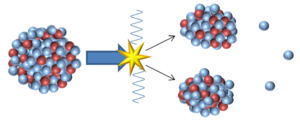Key Stage 4
Meaning

An model of nuclear fission.
Nuclear fission is a process in which a large unstable nucleus splits into two more stable nuclei.
About Nuclear Fission
- Nuclear fission occurs when a massive nucleus is so unstable that it splits in two.
- During nuclear fission neutrons are also emitted.
- Nuclear fission transfers energy from the nuclear potential energy store into the thermal energy store of the material and the surroundings.
- In a nuclear fission reaction the products have less mass than the reactants as some of the rest mass is converted into energy in the process due to the Mass-Energy Equivalence.
- Nuclear fission can be induced in a material by bombarding massive nuclei with neutrons. If a neutron is captured by the nucleus it becomes so unstable that it splits in two.
- The neutrons used to induce fission must have a low energy to be captured by a nucleus otherwise the neutrons will just pass straight through without being captured. Neutrons with the right amount of energy to be captured are called thermal neutrons because they have a similar energy to molecules in the air at room temperature.
| A model showing a possible mechanism for induced nuclear fission resulting from the capture of a thermal neutron.
\({}_{92}^{235}U + {}_{0}^{1}n \rightarrow {}_{92}^{236}U \rightarrow {}_{36}^{85}Kr + {}_{56}^{148}Ba + 3{}_{0}^{1}n\) |
- If there is enough of an unstable isotope in a material a single nuclear fission can trigger a nuclear chain reaction in which the neutrons produced from the initial fission event can cause the fission of more than one other unstable isotope.
- A nuclear fission chain reaction is used in both nuclear bombs and nuclear reactors in nuclear power stations.
